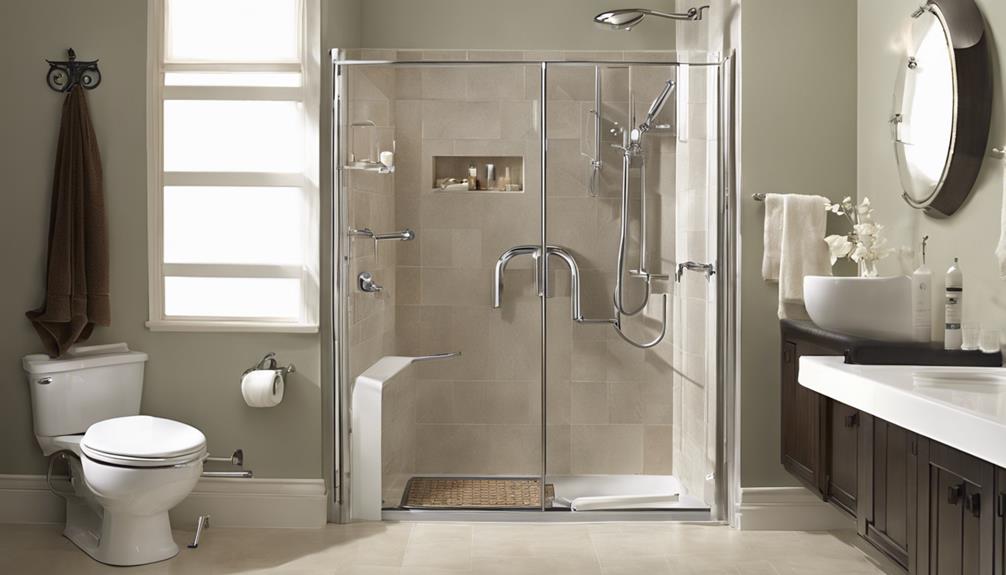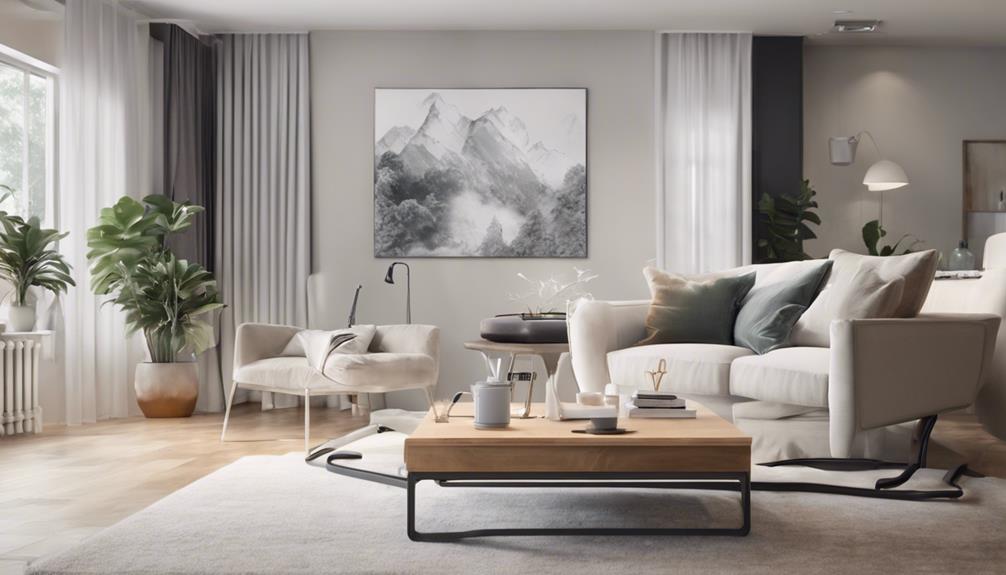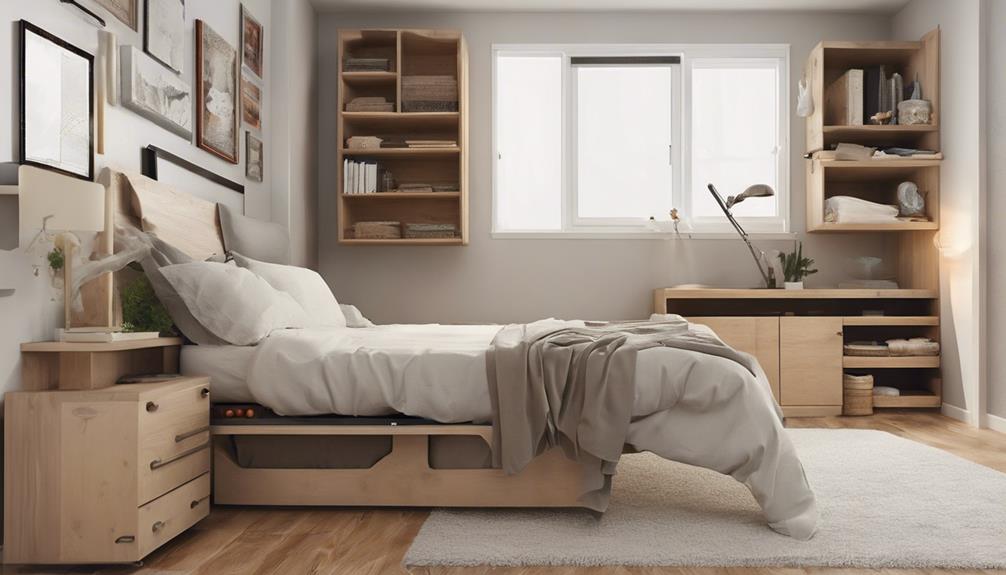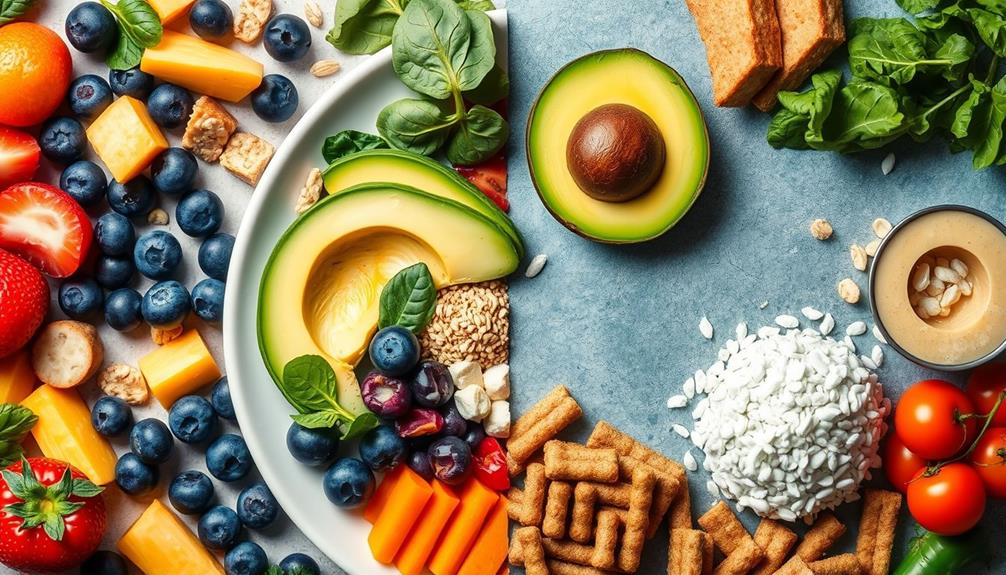When modifying homes for seniors, focus on safety and functionality. Evaluate accessibility needs like mobility and vision. Address tripping risks with grab bars and ramps. Use resources like Home Safety Checklist and Is My Home HomeFit. Explore funding sources and insurance options for financial aid. Hire licensed contractors with proper insurance for reliability. Must-have modifications include grab bars and non-slip flooring. Enhance bathrooms with safety features like shower chairs and elevated seats. Adapt kitchens with adjustable countertops and lever handles. Technology like medical alerts and smart home systems improve safety. Consider DIY projects for cost-effective solutions. Room-by-room modifications promote independence. For more details on home modifications, discover additional information within the provided research.
Key Takeaways
- Prioritize safety and functionality in home modifications.
- Focus on mobility, vision, and safety factors.
- Address potential hazards like poor lighting and tripping risks.
- Install grab bars, ramps, and non-slip flooring for accessibility.
- Utilize resources like Home Safety Checklist for guidance.
Evaluating Home Accessibility Needs
In evaluating home accessibility needs for seniors, we prioritize safety and functionality above all else. When looking at each room, we focus on factors such as mobility, vision, and safety to guarantee a secure environment for our loved ones.
Examining potential hazards like tripping risks, narrow doorways, or poor lighting is vital in making the necessary modifications. By considering mobility challenges, we can identify areas where grab bars or ramps might be needed to enhance accessibility. Addressing vision concerns, such as inadequate lighting or slippery floors, is essential to prevent accidents. Our goal is to create a space that promotes independence and reduces the risk of falls.
Using resources like the Home Safety Checklist from Rebuilding Together and the Is My Home HomeFit? guide from AARP can help us conduct a thorough evaluation and determine the specific modifications needed for each area. By taking these steps, we can make our homes safer and more accommodating for our senior loved ones.
Exploring Financial Assistance Options

When considering financing home modifications for seniors, it's vital to explore various funding sources. Grants specifically tailored for seniors, along with potential insurance coverage options, can help cover the costs of necessary upgrades.
Understanding these financial assistance avenues is key in ensuring seniors can make their homes safer and more accessible.
Funding Sources Overview
Exploring financial assistance options for home modifications can greatly alleviate the costs associated with making necessary changes for seniors. Some funding sources include the Older Americans Act, which offers modification and repair funds, and public or private financing options like USDA grants and Medicaid waivers. Seeking help from organizations such as Rebuilding Together, Inc. and local energy and social service departments can also provide support. Additionally, professional contractors often offer reduced rates based on income, making modifications more affordable. Below is a table summarizing some key funding sources:
| Funding Source | Description |
|---|---|
| Older Americans Act | Provides modification and repair funds for seniors aging in place. |
| USDA Grants | Public financing option that offers assistance for home modifications. |
| Medicaid Waivers | Private financing option that can help cover costs of necessary changes. |
| Rebuilding Together, Inc. | Organization that assists in accessing funds for home modifications. |
| Local Energy Departments | Source of support for seniors looking to make energy-efficient modifications. |
Grants for Seniors
Grants for seniors offer valuable financial assistance to cover the costs of essential home modifications, such as grab bars and ramps. These grants, provided by government programs, non-profit organizations, or private foundations, aim to enhance safety and accessibility in seniors' homes.
By offering financial assistance, grants enable seniors to make necessary modifications that support independent living. Some grants are specifically designed for low-income seniors, ensuring that financial constraints don't hinder essential home improvements.
Exploring grant options tailored for seniors can greatly contribute to creating a safer and more accessible living environment. By taking advantage of these resources, seniors can age in place comfortably and securely, knowing that their homes are modified to meet their evolving needs.
Insurance Coverage Options
To secure financial assistance for home modifications, seniors can explore various insurance coverage options that may help offset the costs. Medicare offers coverage for specific home modifications like grab bars and ramps if certain conditions are met. Some Advantage Plans under Medicare also provide support for home modifications to help seniors age in place.
In certain states, Medicaid waivers can offer financial assistance for necessary home modifications. Additionally, seniors can look into USDA grants and state programs that provide funding for home modifications. Exploring these insurance coverage options, along with potential tax incentives, can help reduce the financial burden of making home modifications to create a safer and more comfortable living environment for seniors.
Hiring Reliable Contractors for Modifications

When looking to hire reliable contractors for home modifications, it is essential to verify their licensing, bonding, and insurance for credibility and protection. Ensuring these qualifications can provide peace of mind and safeguard against any potential issues that may arise during the modification process. To help you make an informed decision, consider the following factors when selecting a contractor:
| Criteria | Importance | Actions |
|---|---|---|
| Licensing | High | Verify licenses with the appropriate authorities. |
| Bonding | Medium | Check if the contractor is bonded for financial security. |
| Insurance | High | Confirm adequate insurance coverage for liability protection. |
Must-Have Home Modifications for Seniors

When making essential modifications for seniors' homes, safety in bathrooms and accessibility in the kitchen are key focuses. Installing grab bars in bathrooms can provide vital support to prevent falls, while non-slip flooring in bathrooms and kitchens enhances safety.
Widened doorways and ramp installations also promote easier navigation and movement within the home, catering to seniors' mobility needs.
Safety in Bathrooms
Enhancing bathroom safety for seniors involves strategic installations to prevent falls and promote independence. By incorporating grab bars, shower chairs, elevated toilet seats, and safety steps, older adults can navigate the bathroom with ease and confidence. Grab bars offer stability and support, reducing the risk of falls, while a shower chair enhances comfort during bathing. Elevated toilet seats and safety frames promote independent toileting, ensuring seniors can easily use the facilities. Professional installation of grab bars is essential for proper placement and durability. Safety steps in the bathtub improve accessibility, decreasing the chances of slipping. These modifications create a safer bathroom environment, allowing seniors to maintain their independence while minimizing potential hazards.
| Bathroom Safety Features | Benefits |
|---|---|
| Grab Bars | Stability and support |
| Shower Chair | Comfort during bathing |
| Elevated Toilet Seats | Independent toileting |
| Safety Steps | Improved accessibility |
Accessibility in Kitchen
To enhance kitchen accessibility for seniors, incorporating adjustable height countertops can cater to varying mobility needs.
Lever-style handles on cabinets and drawers make it simpler for seniors with arthritis or limited hand strength to access kitchen items easily.
Pull-out shelves and drawers allow seniors to reach items at the back of cabinets without straining or bending, promoting independence and safety.
Adding task lighting under cabinets can improve visibility and safety while cooking or preparing meals, reducing the risk of accidents.
Consider installing a touchless faucet with motion sensor technology to make handwashing easier for seniors, eliminating the need to twist or turn handles.
These modifications can create a more user-friendly and accessible kitchen environment for elderly individuals.
Utilizing Technology for Safety

Smart home technology offers remote monitoring and safety features that benefit seniors living independently at home. When considering home modifications for aging in place, integrating technology can greatly enhance safety and security. Here are three key ways technology can help seniors stay safe:
- Medical Alert Systems: These devices provide quick emergency response at the press of a button, ensuring help is always within reach. Knowing assistance is readily available can bring peace of mind to both seniors and their loved ones.
- Specialized Smoke Alarms: Equipping the home with smoke alarms designed for seniors can be life-saving. These alarms are louder and have visual alerts, ensuring prompt evacuation in case of fire emergencies.
- Thermostat Control: Upgraded thermostats can help regulate temperature levels, promoting better health and comfort. Maintaining a comfortable environment is essential for seniors, especially those with medical conditions.
Affordable DIY Home Modifications

For seniors looking to make cost-effective improvements to their homes, DIY modifications offer a practical solution. DIY home modifications cater to the needs of aging in place by providing affordable options to enhance safety and accessibility within the home environment.
Simple projects like easy-grip knobs or non-slip floor coverings can be implemented for as little as $20, making it a budget-friendly choice. Basic tools and materials required for these modifications are readily available at hardware stores or online retailers, ensuring accessibility for all.
Installing lever-style door handles or grab bars are easy DIY tasks that can greatly enhance safety and convenience for seniors. One of the advantages of DIY projects is the flexibility they offer in customizing modifications to suit individual preferences and specific needs.
Room-by-Room Modification Guide

As we delve into discussing the 'Room-by-Room Modification Guide,' let's start by exploring practical ways to enhance safety and comfort for seniors in different areas of their homes.
- Bathroom: Install grab bars for stability, a shower bench for convenience, and non-slip flooring to prevent falls. These adjustments promote independence and security during daily hygiene routines.
- Kitchen: Consider lever-style door handles for easy access, higher countertops to reduce bending, and pull-out shelves for better reach. These modifications enhance the kitchen's functionality and make cooking and meal preparation more accessible for seniors.
- Outdoor Spaces: Install ramps for wheelchair or walker accessibility, handrails for support, and make sure well-lit pathways for visibility. These changes enable seniors to navigate outdoor areas safely and independently.
Maximizing Property Value Through Modifications

To enhance the market appeal of a property, strategic modifications tailored to seniors' needs can greatly boost its value. By focusing on aging-in-place modifications that prioritize safety and accessibility, homeowners can see a potential increase in property value of up to 10%, as reported by the National Association of Home Builders.
Key modifications such as installing grab bars, ramps, and non-slip flooring not only enhance the functionality of a home for seniors but also make it more attractive to a broader range of potential buyers. Investing in these modifications not only allows seniors to enjoy their homes longer but also increases the home's marketability and desirability.
Frequently Asked Questions
What Are Examples of Home Modifications?
Examples of home modifications include installing grab bars for safety and support, adding ramps to aid mobility, adjusting flooring for slip-resistance, installing stairlifts for accessibility, and incorporating bathroom modifications like non-slip decals and handrails.
How to Design for a Senior Home?
We focus on designing senior-friendly homes by incorporating safety features like grab bars, rocker-style light switches, and smart home technology. Optimizing space through decluttering and organizing enhances mobility. Ensuring bathroom safety with essential equipment promotes comfort and accessibility for seniors.
What Is Home Modification and How Does It Support Aging in Place?
Enhancing safety, accessibility, and comfort, home modification empowers seniors to age in place. By customizing living spaces with grab bars, ramps, and more, we enable independence and well-being, allowing seniors to thrive.
What Is the Most Desirable Home Design for Aging in Place?
For aging in place, the most desirable home design focuses on safety, accessibility, and comfort. Features like grab bars, non-slip flooring, and lever-style door handles are essential. Leveraging technology and universal design principles enhances usability for all.
Conclusion
To summarize, making home modifications for seniors is an essential step in ensuring their safety and independence.
By assessing accessibility needs, exploring financial assistance options, and hiring trustworthy contractors, you can create a comfortable and secure living environment for your loved ones.
Remember, every minor adjustment can make a significant impact in enhancing their quality of life. So, take the necessary steps to modify your home and provide a safe space for seniors to thrive. Incorporating dementiafriendly home design ideas, such as implementing clear navigation cues and reducing clutter, can help minimize confusion and promote independence. Simple changes like adequate lighting, contrasting colors for important objects, and creating familiar surroundings can go a long way in ensuring comfort and safety. By carefully considering these thoughtful modifications, you can create an environment that empowers seniors to feel more secure and confident in their daily lives.









